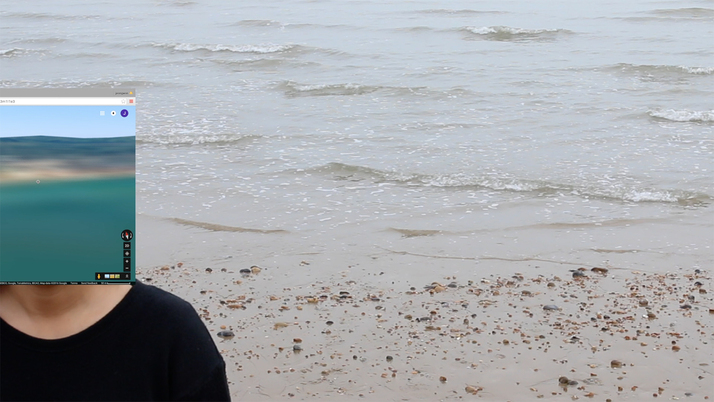-
From Current Issue
-
- Editor’s Letter Fire in the Heart
- Reviews I Gusti Ayu Kadek Murniasih
- Reviews 11th Seoul Mediacity Biennale: “One Escape at a Time”
- Dispatch Networked China
- One on One Monira Al Qadiri on Yukio Mishima
- Essays The rise of independent art spaces in pandemic-era Shanghai
- Features Tuan Andrew Nguyen
- Table of Contents
- Web Exclusives
- Archive
- Subscribe

R
E
V N
E
X
T
EOM JEONGWON, When I Want to Fit into a Frame, 2016, still from single-channel projection across paper screens and the wall: 7 min. Courtesy Korean Cultural Centre UK, London.
A ratio colon signifies the relationship between two interdependent entities.
The name of Eom Jeongwon’s first solo exhibition in the United Kingdom, “1:60,” refers to an untitled participatory performance that took place on the show’s opening night, in which 60 guests were given colored pens to trace their own outlines on the Korean Cultural Centre UK’s walls and windows. This not only revealed something of the unseen interaction between artist, artwork and viewer, but also modified and recorded it, assigning new roles to each and marking the outcome in the exhibition space. Much of the work in “1:60” operated similarly by seeking to project relationships onto spaces where they might otherwise go unseen.
Trip (2017)—a single-channel projection consisting of footage from rural Iceland and Dungeness, England—begins with a shot of breaking waves on an isolated beach, before panning to focus on the cliffs facing the water. When the camera returns to the waves, a moment is required to notice that they have become static, and then a few more to recognize the image’s distortion each time the perspective shifts. A transparent compass in the top right corner of the screen, and a barely visible watermark, confirm we are looking at the beach through Google Street View. “So why Iceland? To get lost,” a voice asks and answers. We see the suggestion that even seemingly untouched spaces are connected to a digital infrastructure that expands across the globe, and this connectivity modifies our perception of scale when viewing the wilderness: the possibility of getting lost is made ironic.
EOM JEONGWON, Looking at the Below on a Road, 2016, video installation, multi-channel projection on a bike frame powered by a cake mixer. Installation view of the exhibition "1:60,” at Korean Cultural Centre UK, London, 2017. Courtesy Korean Cultural Centre UK.
Elsewhere, the artist attempted to explore the capacity of physical infrastructure and objects to connect places and things. In Looking at the Below on a Road (2016), a device constructed from a cake mixer and a bicycle rotated two mounted projectors in a darkened room. These illuminated the surrounding space with footage of power lines against wide-open skies. The configuration of these objects sought to reveal their connection to the electrical infrastructure that powered them, but their use and relevance to each other were arbitrary. To reveal such underlying relationships convincingly would require a less contrived starting point, so the inclusion of the objects in the installation, and of the installation in the exhibition, was extraneous.
On a more personal scale, When I Want to Fit into a Frame (2016) sought to show the relationship between the artist’s body and the space it occupied. A single video in which Eom positioned herself in various ways was projected onto five concentric screens of decreasing sizes, hung one in front of the other. This layering allowed the image to expand into three dimensions, altering the viewer’s perception of the piece depending on where they stood. Similarly, among the traces left on the walls by visitors at the exhibition’s preview were two easily ignored sets of red lines constructed according to an obscure geometry—one splayed obliquely over a corner near the ground, and another overlaying struts on the gallery’s ceiling. It was only when standing in the correct position that a visitor might have noticed that each set of lines, seen at a specific angle, formed a perfect square. Once again, this intimated a subjective relationship between artist, artwork and viewer, but it was unclear how these pieces related coherently to others in the show.
EOM JEONGWON, When I Want to Fit into a Frame, 2016, single-channel projection across paper screens and the wall: 7 min. Courtesy Korean Cultural Centre UK, London.
Although Eom’s creations have a strong aesthetic quality and hint promisingly at the beginnings of a compelling enquiry into our relationship with space, this early offering from an artist who is yet to complete her masters at London’s prestigious Slade School of Fine Art lacked coherence. It is ironic that a show so concerned with the relationship between things failed to reveal one between its own constituent parts.
Eom Jeongwon’s “1:60” is on view at the Korean Cultural Centre UK, London, until April 22, 2017.
To read more of ArtAsiaPacific’s articles, visit our Digital Library.







